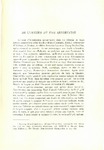Πλοήγηση ανά Θέμα "Byzantium"
Αποτελέσματα 1-12 από 12
-
De Torigine du nom Ακομινάτος
(Εταιρεία Βυζαντινών Σπουδών, 1953) -
Icons
(2012)The icon may well be one of the most important legacies of Byzantium. Icons were pervasive in Byzantine society and the most characteristic products of the Orthodox Church. The funeral portraits known as Fayyum, named after ... -
Ophthalmic malignancies in antiquity as depicted in two terracotta figurines
(2015)Ocular and orbital wall cancers were recognized by the physicians of the antiquity as incurable, lethal, and non-operable malignant entities. Paul of Aegina (7thc AD) was the first to refer to this type of cancer and ... -
Papst und Patriarch unter Kaiser Manuel I. Kommenow
(Εταιρεία Βυζαντινών Σπουδών, 1953) -
Paul of Aegina (c. 625–690 AD), the Origins of the Early Correction of Pediatric Strabismus in Byzantine Empire
(2016)The eminent Greek physician Paul of Aegina, native of the Saronic island Aegina and pupil of the Alexandrian School, understood both exotropia and endotropia, his designation for esotropia and proposed therapeutic measures ... -
Remedies of animal origin and their indications in Nikolaos Myrepsos׳ Dynameron
(2021)Ethnopharmacological relevance: Dynameron is a Byzantine medical compendium, divided into 24 sections, in accordance with the letters of the Greek alphabet. Being the largest medical and pharmaceutical book ever written ... -
Βιβλιοκρισίαι: St. G. Kapsomenakis, Voruntersuchungen zu einer Grammaiik der Papyri der nachchristlichen Zeit. Μόναχον 1938 Σελ. 148+XVI
(Εταιρεία Βυζαντινών Σπουδών, 1938) -
Βυζαντινών τροφαί και ποτά
(Εταιρεία Βυζαντινών Σπουδών, 1941)L’auteur base sur les reinseignements fournis par les peres de l’eglise, les ouvrages des medecins byzantins, les livres agronomiques et les glossaires du moyen age, les rituels des couvents, les livres onirocritiques et ... -
Επί τη 1600η επετηρίδι του θανάτου του Μ. Κωνσταντίνου (337-1937)
(Εταιρεία Βυζαντινών Σπουδών, 1937)La souligne que l’honneur s’impose a cette occasion a Constantin le Grand, sauveur, meme provisoire, de l’Empire Romain, qui tant exterieurement qu’interieurement courait le danger d’etre dissout vers la fin du IIIe s. ap. ... -
Ο Μέγας Κωνσταντίνος και η λατρεία των αυτοκρατόρων
(Εταιρεία Βυζαντινών Σπουδών, 1931)Constantin fut adore de son vivant comme dieu par les pa’iens ainsi que par des chretiens qui conservaient encore leurs habitudes pai’ennes. L’a. parle de ses statues et discute les renseignements donnes par les chroniqueurs ... -
Ο Μιχαήλ Ψελλός ως λαογράφος
(Εταιρεία Βυζαντινών Σπουδών, 1953) -
«Τροφαί και ποτά» εις πρωτοβυζαντινούς παπύρους
(Εταιρεία Βυζαντινών Σπουδών, 1953)









